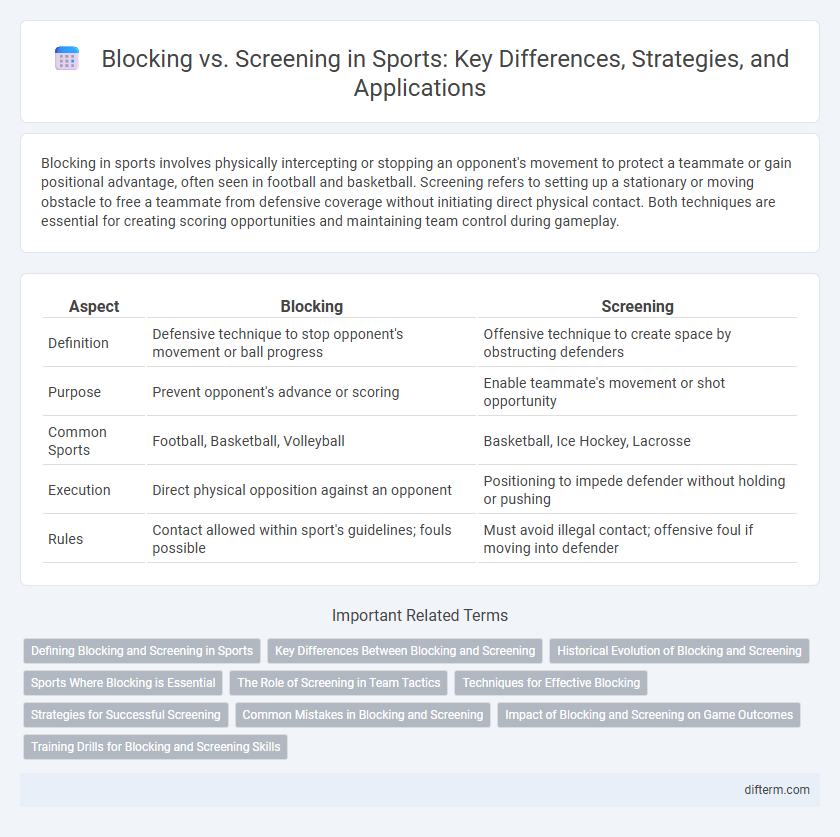Blocking in sports involves physically intercepting or stopping an opponent's movement to protect a teammate or gain positional advantage, often seen in football and basketball. Screening refers to setting up a stationary or moving obstacle to free a teammate from defensive coverage without initiating direct physical contact. Both techniques are essential for creating scoring opportunities and maintaining team control during gameplay.
Table of Comparison
| Aspect | Blocking | Screening |
|---|---|---|
| Definition | Defensive technique to stop opponent's movement or ball progress | Offensive technique to create space by obstructing defenders |
| Purpose | Prevent opponent's advance or scoring | Enable teammate's movement or shot opportunity |
| Common Sports | Football, Basketball, Volleyball | Basketball, Ice Hockey, Lacrosse |
| Execution | Direct physical opposition against an opponent | Positioning to impede defender without holding or pushing |
| Rules | Contact allowed within sport's guidelines; fouls possible | Must avoid illegal contact; offensive foul if moving into defender |
Defining Blocking and Screening in Sports
Blocking in sports refers to legally obstructing an opponent's movement to prevent them from reaching a specific area, often used in football and basketball to protect the ball carrier or create space. Screening involves positioning a player to shield a teammate from a defender, facilitating better ball control or an open shot, commonly seen in basketball. Both techniques require precise timing and spatial awareness to be effective without committing fouls.
Key Differences Between Blocking and Screening
Blocking involves physically stopping or impeding an opponent's movement to protect a teammate or create space, primarily used in football and basketball. Screening refers to setting a stationary position to shield a teammate from a defender, allowing free movement toward the basket or strategic positioning. The key difference lies in blocking being an active, forceful engagement, while screening is more about positioning and timing to create an advantage without illegal contact.
Historical Evolution of Blocking and Screening
Blocking and screening have evolved significantly in sports, originating from early football and basketball tactics in the late 19th and early 20th centuries. Blocking, initially developed in American football, involves physically obstructing opponents to protect the ball carrier, while screening emerged in basketball as a strategic move to free teammates from defenders. Both techniques have been refined with rule changes and coaching innovations, becoming fundamental components in modern team sports dynamics.
Sports Where Blocking is Essential
Blocking is a fundamental technique in American football, where offensive linemen prevent defenders from tackling the quarterback or ball carrier. In basketball, while screening is common, blocking is critical on defense to stop opponents' drives and shots effectively. Hockey also relies on blocking, with players using their bodies to obstruct pucks and protect the goalie during intense game moments.
The Role of Screening in Team Tactics
Screening in team sports serves as a strategic technique to shield a teammate from opponents, facilitating better ball control and creating scoring opportunities. Unlike blocking, which directly stops an opponent's movement, screening positions a player to obstruct defenders' vision and paths, enhancing offensive fluidity. Effective screening requires precise timing and spatial awareness to disrupt defensive setups and enable successful team plays.
Techniques for Effective Blocking
Effective blocking in sports relies on maintaining a low stance with bent knees to maximize balance and leverage against opponents. Hand placement should be firm but controlled, targeting the opponent's torso to impede movement without committing fouls. Footwork is critical, requiring quick, shuffling steps to adjust positioning and sustain the block throughout dynamic plays.
Strategies for Successful Screening
Effective screening strategies involve precise positioning and timing to create space for teammates without committing fouls. Players must maintain a legal stationary stance, anticipating defenders' movements to maximize the screen's impact. Clear communication and awareness of court spacing enhance the success rate of screens, facilitating open shots and offensive flow.
Common Mistakes in Blocking and Screening
Common mistakes in blocking and screening include poor positioning that fails to create effective space or obstruct opponents adequately. Players often neglect proper footwork and timing, resulting in missed screens or ineffective blocks that lead to early contact or foul calls. Miscommunication and lack of awareness of teammates' movements further reduce the success of these fundamental tactics in basketball and football.
Impact of Blocking and Screening on Game Outcomes
Blocking directly influences game outcomes by preventing opponents from advancing, creating space and time for offensive plays, and increasing scoring opportunities. Screening, by obstructing defenders' vision and movement, facilitates successful shots and cuts, thereby enhancing team coordination and efficiency. Both blocking and screening strategically shape game dynamics, often tipping the balance between victory and defeat in competitive play.
Training Drills for Blocking and Screening Skills
Effective training drills for blocking and screening focus on developing core techniques such as footwork, body positioning, and hand placement to create space and maintain defensive control. Drills like partner resistance blocking, cone agility exercises, and screen-setting simulations enhance muscle memory and reaction time important for offensive and defensive maneuvers. Incorporating progressive resistance and real-game scenarios ensures athletes improve timing, strength, and communication necessary for successful blocking and screening in basketball.
Blocking vs Screening Infographic

 difterm.com
difterm.com